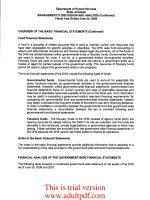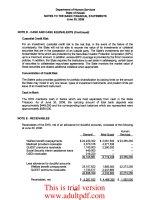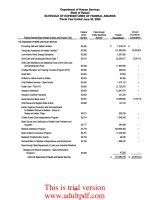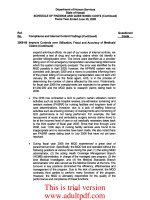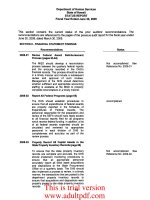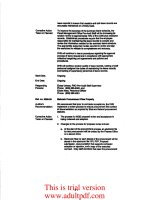Department of Human Services Child Support Enforcement Division Financial-Related Audit For the Period October 1, 1997, through March 31, 1999 October 1999 _part3 potx
Bạn đang xem bản rút gọn của tài liệu. Xem và tải ngay bản đầy đủ của tài liệu tại đây (39.01 KB, 10 trang )
Department of Human Services’ Child Support Enforcement Division
17
Conclusions
The Department of Human Services designed and implemented controls to prevent unauthorized
access to child support data. However, the department has not adequately prevented conflicts of
interest by employees who may be a party to a child support case. The department did not
restrict system users who were a party to a child support case from accessing and modifying their
own data.
Generally, the department granted system access that appeared reasonable for related job
functions. However, the department did not adequately secure the VIPRS application from
modifications or system deletions. In addition, the department did not adequately secure certain
child support batch processing jobs on the state’s mainframe computer.
6. The Department of Human Services did not provide a means to prevent or detect
conflicts of interest relating to child support cases.
The department did not implement controls to prevent state and county users of the PRISM
system from accessing or modifying child support cases in which they may have an interest. The
department also did not have a means to detect if any users had made modifications to their own
cases. As of June 1999, approximately 2,945 state and county employees had access to the
PRISM system. Some of those employees might be recipients of child support or may have child
support obligations. The department lacked controls to identify those individuals and prevent
them from accessing or modifying their own case files. This creates a potential conflict of
interest. Users could inappropriately update their own data or have access to child support cases
Figure 5-1
Controlling Access to PRISM Child Support Screens and Data
Request To Use
PRISM Screen
ACF2
ACF2
ACF2 ACF2
PRISM
(Over 400 Screens)
Natural/Adabase
Software
Adabase Tables
1 2
3
1
= ACF2 confirms that user
has clearance to access
the mainframe.
2 = PRISM security profile
gives user clearance to
use specific screens.
3
= PRISM interacts with
Natural/Adabase to
determine if user has
clearance to display,
create, update, or delete.
data.
Mainframe Computer at Intertech
Wide Area
Network /
Internet
Source: Auditor Prepared.
Department of Human Services’ Child Support Enforcement Division
18
containing confidential information not normally disclosed to the parties of the child support
cases.
Recommendations
• The Department of Human Services should identify PRISM system users who
are recipients of child support or have child support obligations.
• The department should restrict users from accessing or modifying child
support cases in which they have an interest.
7. The Department of Human Services did not adequately secure VIPRS programs and
data.
The department did not adequately secure the VIPRS application and its data from unauthorized
modifications or deletions. We concluded that the department did provide adequate security if a
user accessed data through the VIPRS application. However, the department’s network security
allowed all users of VIPRS a backdoor method to access the underlying system program and data
files. As such, the VIPRS system is vulnerable to intentional and unintentional modifications.
The department told us that it established the current system security configuration in order to
allow the VIPRS system to operate. However, the current security structure presents the
department with unnecessary risks, so alternative security functions should be pursued.
Recommendation
• The department should pursue and implement network security which prevents
unnecessary access to VIPRS program files and stored data.
8. The Department of Human Services did not adequately secure certain batch production
jobs.
The department did not properly secure certain batch jobs related to the VIPRS and PRISM
system. Batch jobs are a collection of program files that perform predefined tasks. The
department stores these jobs on the state’s centralized mainframe in a file structure referred to as
datasets. Controlling access to these datasets is crucial to prevent inappropriate use or
modification of the jobs. However, the department granted inappropriate access to those datasets
and batch jobs. We found that 29 Department of Human Services and Services Design
Associates employees had access to batch processing. The department should limit this access to
only the few employees who need it to perform their job responsibilities.
Recommendation
• The department should limit access to batch processing jobs to users who
need it to perform their normal job duties.
Department of Human Services’ Child Support Enforcement Division
19
Chapter 6. Child Support Incentive Bonuses
Chapter Conclusions
The Department of Human Services designed and implemented internal
controls to provide reasonable assurance that child support enforcement
incentive payments made to Minnesota counties and health care providers were
in compliance with applicable legal provisions.
The Department of Human Services pays state incentives to its 84 county service centers and to
health care providers for establishing paternity and child support orders, as mandated by Minn.
Stat. Section 256.979. The department also pays state incentives to counties for enforcement of
orders for parents to provide health insurance coverage for dependent children, as directed by
Minn. Stat. Section 256.9791. The department paid out approximately $2.9 million in state
funds for child support and medical support incentives during the period October 1, 1997, to
March 31, 1999.
Pursuant to statute, the department pays the following child support incentives:
• A $100 incentive to counties for each court order that they establish and for modifications
made to existing support orders.
• A $100 bonus incentive to counties for each legal action that results in a determination of
paternity and for each recognition of paternity that the counties filed with the Minnesota
Department of Vital Statistics.
• A $50 incentive for establishing dependent health insurance coverage under a non-
custodial parent’s insurance policy.
• A $25 bonus incentive to health care providers for each filed recognition of paternity.
County child support personnel enter transactions that qualify for incentives onto the PRISM
system. System edits check the validity of the claim in accordance with Minn. Stat. Sections
256.979 and 256.9791 and reject invalid claims. If the claim meets the requirements, the system
calculates the appropriate bonus incentive amounts. The department uses the PRISM system
reports to determine quarterly disbursement amounts to counties.
The department bases bonus incentives for health care providers on the number of parentage
recognition forms that they submit. These incentives are tabulated manually since the health
care providers do not have PRISM access. Each quarter, a summary of bonus incentives owed to
health care providers is prepared and payments are distributed to the health care providers.
Department of Human Services’ Child Support Enforcement Division
20
Audit Objective and Methodology
Specifically, our review of child support bonus incentives focused on the following question:
• Did the department design and implement internal controls to ensure child support bonus
incentives were accurately paid and complied with Minn. Stat. Sections 256.979 and
256.9791?
To answer this question, we interviewed staff to obtain an understanding of the internal controls
over the authorization, calculation, and payment of child support and medical incentives. We
reviewed applicable policies, procedures, and legal provisions. Further, we tested a sample of
transactions to determine if the incentives complied with applicable legal provisions.
The department disbursed various federal and state child support incentives to counties and
health care providers during the audit period. However, this audit focused only on incentives
paid with state funds.
Conclusions
The Department of Human Services designed and implemented internal controls to provide
reasonable assurance that child support and medical incentive payments were accurate and in
compliance with Minn. Stat. Sections 256.979 and 256.9791.
Department of Human Services’ Child Support Enforcement Division
21
Status of Prior Audit Issues
As of June 23, 1999
Related Legislative Audit
March 12, 1999, Legislative Audit Report 99-17 examined the Department of Human
Services’ activities and programs material to the State of Minnesota’s Annual Financial Report
or the Single Audit for the year ended June 30, 1998. The scope of that audit included a
financial statement review of child support collections and disbursements, as well as a Single
Audit review of certain reporting and expenditure reimbursements related to the Federal Title
IV-D program, which provides funding to states and counties for child support enforcement. The
scope of those reviews did not reveal any weaknesses related to our objectives.
Department of Human Services Internal Audit
April 2, 1999, Theft of Checks at the Child Support Payment Center, issued by the
department’s internal audit office, reported on a review of the Child Support Payment Center’s
receipting process as a result of stolen non-custodial parents’ money orders. The report found
that a contractor’s employee stole several money orders and deposited them in a personal bank
account. The contractor’s insurance company is responsible for reimbursing the program for its
losses.
The report made several recommendations for improving Child Support Payment Center policies
and procedures. Significant issues included the use of employee background checks, monitoring
employee activities through the use of camera surveillance and adequate lines of vision, and
procedures for tracking incoming checks which require special attention. The department
implemented the recommendations identified in the report, except that it still does not perform
background checks on its employees. We discuss the lack of background checks in Finding 1 of
this report.
Federal System Certification
May 26, 1998, PRISM Certification Review Report was issued by the Federal Department of
Health and Human Services, Administration for Children and Families – Office of Child Support
Enforcement. The office conducted a certification review of the PRISM system in March 1998.
The review consisted of 53 specific objectives, in the areas of case initiation, location of parents,
establishment of paternity, case management, enforcement, financial management, reporting, and
security and privacy. The review team found that, generally, the PRISM system met the specific
certification requirements and granted the State of Minnesota a conditional level II certification
of the PRISM system. The team did, however, make certain findings and recommendations in its
report. In the financial management area, the report stated that certain distributions of support
collections do not comply with federal requirements for foster care cases and arrearage cases
where non-custodial parents had multiple child support cases. The department has not resolved
these issues, and they are discussed in Findings 2 and 5 of this report.
State of Minnesota Audit Follow-Up Process
The Department of Finance, on behalf of the Governor, maintains a quarterly process for following up issues cited in financial
audit reports issued by the Legislative Auditor. The process consists of an exchange of written correspondence that documents
the status of audit findings. The follow-up process continues until Finance is satisfied that the issues have been resolved. It
covers entities headed by gubernatorial appointees, including most state agencies, boards, commissions, and Minnesota state
colleges and universities. It is not applied to audits of the University of Minnesota, any quasi-state organizations, such as
Metropolitan agencies or the State Agricultural Society, the state constitutional officers, or the judicial branch.
Department of Human Services’ Child Support Enforcement Division
22
This page intentionally left blank.
Minnesota Department of Human Services
September 24, 1999
James R. Nobles
Legislative Auditor
Centennial Office Building
658 Cedar Street
St. Paul, MN 55155
Dear Mr. Nobles:
The enclosed material is the Department of Human Services response to the findings and
recommendations included in the draft audit report of the Department’s Child Support
Enforcement Division financial related audit conducted by your office for the period
October 1, 1997 through March 31, 1999. It is our understanding that our response will
be published in the Office of the Legislative Auditor’s final audit report.
The Department of Human Services policy is to follow-up on all audit findings to
evaluate the progress being made to resolve them. Progress is monitored until full
resolution has occurred. If you have any further questions, please contact David
Ehrhardt, Interal Audit Director, at (651) 282-9996.
Sincerely,
Michael O’Keefe
Commissioner
Enclosure
cc: Jeanine Leifeld
Mark Mathison
444 Lafayette Road North
•
Saint Paul, Minnesota
•
55155
•
An Equal Opportunity Employer
Department of Human Services
Child Support Enforcement Division
Financial Related Audit
For the Period October 1, 1997, through March 31, 1999
1
Audit Finding #1
The Department of Human Services does not conduct criminal background checks of potential child
support employees.
Audit Recommendation #1-1
The department should conduct criminal background checks of potential employees having
access to child support funds.
Department Response #1-1
The Department also shares the Legislative Auditor’s concern about the lack of background checks for
employees who process child support funds. Currently, the Department has a department-wide
committee reviewing the issue of background checks. Along with studying the various types of
background checks that could be implemented by the Department, they will be reviewing the
Department's operating structure to determine areas within the Department that need background
checks. The Child Support Enforcement Division (CSED) along with the other department divisions
will be providing information to this committee. Additionally, CSED will present to the committee a
copy of this finding and recommendation. The committee will report to the Department's Senior
Management Team the various options that could be implemented at the Department.
Person Responsible: Shirley Sundquist, Human Resources Division
Estimated Completion Date: August 31, 2000
Audit Recommendation #1-2
The Department of Human Services should seek clarification as to whether periodic background
checks are required in order to maintain valid insurance on its employees.
Department Response #1-2:
The Department agrees with the recommendation. The Department will contact the Risk Management
Division of the Department of Administration and request verification as to whether periodic
background checks are required to maintain valid employee dishonesty insurance.
Department of Human Services
Child Support Enforcement Division
Financial Related Audit
For the Period October 1, 1997, through March 31, 1999
2
Person Responsible: Gregory Poehling, Direct Services Manager, CSED
Estimated Completion Date: November 1, 1999
Audit Finding # 2
The Department of Human Services did not properly distribute funds for some non-custodial parents
with multiple child support cases.
Audit Recommendation #2-1
The Department of Human Services should correct the PRISM system to properly allocate child
support payments to multiple cases with past-due obligations.
Department Response #2-1:
The Department agrees with the recommendation and is working on the changes. As the audit
recognizes, federal regulations do not specify how to distribute payments on past-due support when a
noncustodial parent has more than one case. In all cases, money collected by the Department to pay
child support has been used to pay debts owed by the noncustodial parents. The issue is whether the
debts of the noncustodial parents are being paid off in an appropriate order.
The Department has been in contact with the federal government with regard to this issue and plans to
make the necessary changes when other modifications are made to distribution. On May 18, 1999, the
federal government approved the Department’s plan and time line for making the necessary changes.
Person Responsible: Mary Arvesen, PRISM Manager, CSED
Estimated Completion Date: October 1, 2000
Audit Recommendation 2-2
The department should determine the overall extent of the actual misallocation and work with
the federal Office of Child Support Enforcement to determine if any corrective actions are
necessary.
Department of Human Services
Child Support Enforcement Division
Financial Related Audit
For the Period October 1, 1997, through March 31, 1999
3
Department Response #2-2:
The Department has contacted the Federal Regional Office in Chicago. The Regional Program
Manager indicated that the federal agency will not be requiring additional action. The Department will
not be taking additional corrective actions on distributions prior to the changes in recommendation #2-1.
Person Responsible: Mary Arvesen, PRISM Manager, CSED
Estimated Completion Date: Completed
Audit Finding #3
The Department of Human Services did not properly distribute funds to some custodial parents who
had received public assistance.
Audit Recommendation #3-1
The Department of Human Services should correct the PRISM system to properly allocate child
support payments between public and non-public assistance.
Department Response #3-1:
The Department agrees with the recommendation and will change the PRISM system to properly
allocate child support payments in the situations identified in this recommendation. These changes are
not complex. The work can be done independent of the changes required under PRWORA.
Preliminary evaluation to determine the extent of the misallocation indicates that fewer than 1500 cases
could have been impacted by this finding. Currently, as these misallocations are identified, adjustments
are made by the department.
Person Responsible: Mary Arvesen, PRISM Manager, CSED
Estimated Completion Date: November 1, 1999

